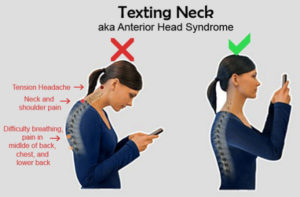Tablet and mobile device use is increasing throughout schools and workplaces, and with it grows the reports of neck pain and repetitive strain injury. So, if your iPad is more ow-Pad and you take pain relief because of your tablet, you may be suffering from ‘tech neck’.

Tech-neck is responsible for increased levels of discomfort and reduced range of movement in many mobile device users, having a negative impact on an individual’s ability to perform at work and participate fully in social activities.
Who is most at risk?
– Devices users who spend between two to four hours a day with their heads tilted downwards to look at screens
– High school students
How does it happen?
Tech-neck is a musculo-skeletal pain. Understanding which areas are affected can increase awareness of poor postural behaviours and help you to monitor and adjust your own positioning to reduce the risk of developing problems:

Neck pain – Sustained bending (flexion) increases the load on the neck and upper back dramatically.

http://www.berliner-zeitung.de/blob/view/29108108,30347052,data,spine-study
Back pain – Holding your neck in sustained flexion position will mean that your lumbar spine is vulnerable to strain when sitting or standing, increasing the likelihood of musculoskeletal back pain.
Tenosynovitis – The position of the hands and thumbs during frequent repetitive tasks such as texting or emailing puts the tendons at risk of developing tenosynovitis. Tenosynovitis is inflammation surrounding a tendon and can result in pain, swelling and difficulty moving joints. This risk is increased on a mobile phone, because people tend to use a combination of fingers on tablet touch screens.
Headaches – Mobile device users often report headaches. This could be due to a number of reasons:
– The increased load through the cervical spine can lead to ‘cervicogenic’ headaches or tension headaches.
– Increased stress as employees are more likely to take their work home with them and feel the need to check and reply to emails / messages outside of working hours.
– Straining eyes to read smaller text on the screens.
Shoulder pain – Related to the flexed posture of the neck and the shoulders slouching forwards, it can also be triggered by holding devices out in front of you for long periods of time
What can you do?
Here you’ll find our recommendations for reducing the risk of developing ‘tech-neck’:
– Think about your task. Is your mobile device the best tool for the job? Smartphones are ideal for phone conversations, or quick tasks like sending a brief email. However, if you have a lot of reading or typing to do, schedule those tasks for when you have access to a desktop.
– Adjust the size / font of the text on the screen so that it is clearer and quicker to read, if possible.
– Set clear boundaries for checking emails / messages at home.
– When sending and receiving text messages, use two hands to hold the phone and to type. Using two hands keeps the phone more stable, increasing accuracy and reducing the need for unnecessary repetition. It also spreads the workload over two thumbs.
– If possible, raise the device to a more suitable height to reduce the flexion in the neck.
Change positions / posture regularly, ideally, every thirty minutes during long periods on the devices if this situation is unavoidable. This could be a water break, neck or back exercises standing at your desk or a walk at lunch time.
If your symptoms persist, we would always recommend you seek medical advice. As most of the issues discussed here are musculoskeletal, you can book an appointment with our physios for a diagnosis, including personal advice, exercises and treatment.
Click the link below for some useful product ideas to help you improve your posture:
http://osmondgroup.co.uk/res/Handheld_Devices_Posture_Guidance.pdf




